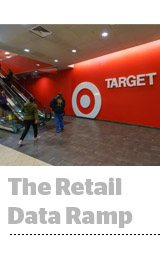 Over the past two years, Target has activated its first-party data so that agencies and its vendor partners – brands that sell products in Target’s stores – could use it to inform media buys.
Over the past two years, Target has activated its first-party data so that agencies and its vendor partners – brands that sell products in Target’s stores – could use it to inform media buys.
Target’s data is applied through a product platform called Guest Access overseen by Kristi Argyilan, Target’s SVP of media, guest engagement and measurement.
The retail giant hired her from Magna Global to develop its media platform model. AdExchanger caught up with her to discuss the challenges and opportunities for a brick-and-mortar giant in a world where automated marketplaces are gaining ground.
AdExchanger: You were hired in 2014 to oversee “paid, earned, shared and owned media,” and have an expansive title. What is your focus at Target?
KRISTI ARGYILAN: My central focus is how to leverage our first-party data to understand how to engage guests more appropriately. We’re obsessed about having a superior [guest] experience, which pushes us as data-driven marketers to think of things in different ways.
We start with humans, not digitally derived audiences, and the data we’re making decisions off of is richer than it’s ever been. So being a part of personalized, relevant content from television down to digital executions has been a big difference for us, and we continue to see stronger performance as a result of that.
So how are you leveraging first-party data?
All the products based on executing against first-party data go through Guest Access.
We have a team that’s developing the marketplace, which currently has inventory from 100-200 publishers. So we’re looking for publishers that provide value to our guests, and securing those deals. Then there are 15 or so experts that drive the programmatic executions [on Target’s in-house trading desk].
Where have you seen growth for Guest Access? And where are you looking for growth moving forward?
The bulk of our revenue growth has come from vendor partners. We have seen some demand from complementary industries, insurance sellers and automotive companies. There’s a sales team calling on agencies and telling our story.
AdExchanger Daily
Get our editors’ roundup delivered to your inbox every weekday.
Daily Roundup
What’s your 2017 focus for Guest Access?
We expect we’ll have some addressable TV within the marketplace we can play around with. The vision for Guest Access is that we’ll have all channels sitting within the platform, and we’re pushing an aggressive agenda to include television, not just video.
The hypothesis is that it’s easy to identify high-rated programming and those audiences, but that there’s a lot of long-tail programming where we’ll be able to find a lot of currency among our guests. Because of industry ratings a lot of that programming carries little value.
What are some of the measurement standards and expectations you see? Are Guest Access campaigns tied to measurable in-store results in any way?
We look at it holistically, and some of the first programs we ran through Guest Access had really strong sales results in our stores.
With vendor partners, the idea is to sell more regardless of being in a store or online, but in many instances our partners appreciate the sales results and are intrigued by the customer insights. They want to know whether they’re customers buy more or less often in a store, or whether they’re serving too many or too few ads to target segments.
Do you have any tech vendors or external partners who contribute to Guest Access, or is it stood up entirely by Target?
We have a tech and services stack we work off. The idea is to borrow off some of the best partners out there while at the same time we build our own capabilities. Merkle is in that stack, as is Google. We also work with Acxiom as a satellite DMP so partners match any data they want to bring.
We’ve worked with other vendors too as we developed our own tools. We keep a pretty rigorous and regular RFP process, and everything is designed specifically to plug in and plug out.
What are the kinds of organizational challenges during this transition to a data-driven marketing and media platform for a retailer?
I would say one of the things we had to push was breaking down the silos. There was an understanding we needed to create a structure where the money could move from one channel to another, but some divisions had very dark lines between them. Different teams had been given independent decision rights and budgets, but communication and budgets didn’t move horizontally.
Now we have everyone sitting at the same table having the same conversation, which is the data.













